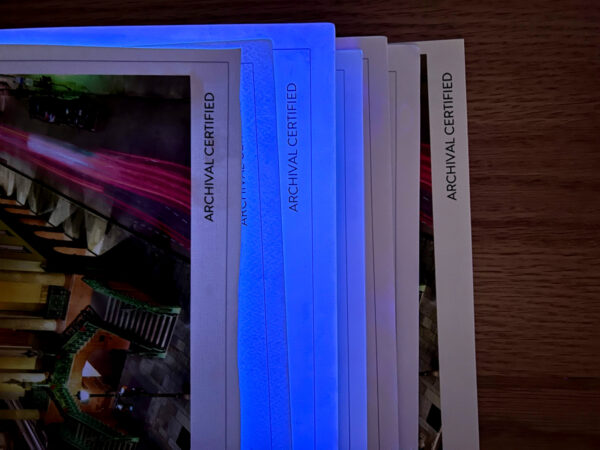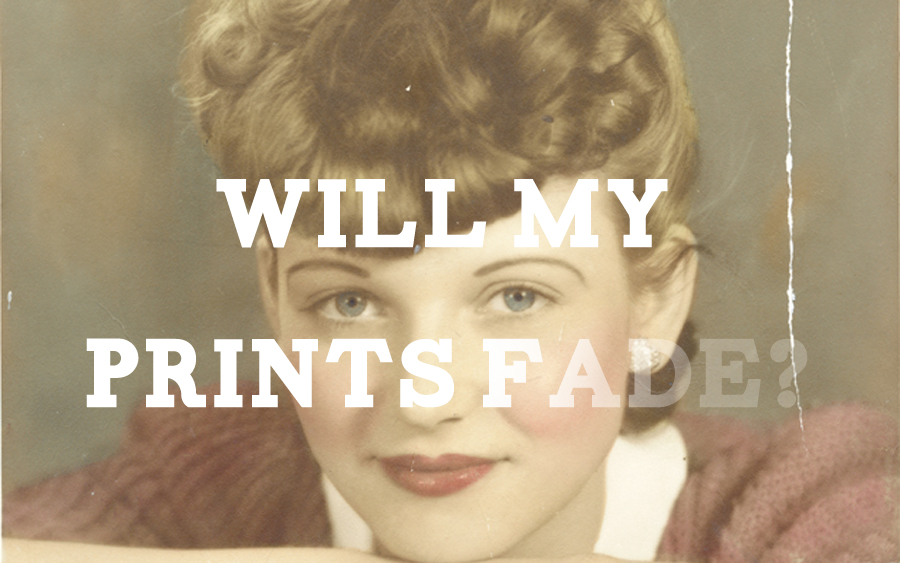“ARE THESE PRINTS ARCHIVAL? HOW LONG WILL THEY LAST?”
These are questions we get asked regularly, and rightly so. Unfortunately, it’s a question much more easily asked than answered. It’s important to understand what someone’s understanding of archival is before answering this question. It’s also important to understand that the longevity of a print relies not only on the printer, paper, and inks but also on you (or whomever will be displaying the print). In fact, the ultimate longevity of a print often depends more upon the end user than the printer.
We can make you a print on archival certified paper that will fade away very quickly if handled and displayed incorrectly. On the other hand, we can make a print which isn’t on an archival certified paper that will last a long time if its matted, framed, and displayed properly.
In this post we’ll go over some very important things to know about archival prints. It’s worth reading through to make sure you have a good understanding of archival printing so that you can both display your prints properly and pass this information along to your customers.
ALL PRINTS ULTIMATELY FADE
Let’s first get this out there: all of your prints will ultimately fade away. Even now we regularly restore photos from the early 2000s (that’s not that long ago is it?) that have been sitting on a table in a frame and the colors have faded. These are photos shot on film and printed on light sensitive paper using traditional photo chemicals.
If you want the maximum longevity possible then your best bet is to shoot traditional black and white film and make prints in a darkroom using black and white papers and chemicals. Even still, those will fade, just not as quickly.
Does that mean you shouldn’t make the effort to get as archival a print as possible? Definitely not, and we do what we can to maximize the life you’ll get out of your prints. The main point here is that the expectation needs to be set that any print is going to fade at some point.
SO WHAT DOES ARCHIVAL MEAN?
archival
adjective
Definition of archival
: of, relating to, contained in, suitable for, or constituting archives
It’s worth mentioning that, when it comes to print longevity, there isn’t really any universally agreed upon standard as to what archival really means. That often leads to a lot of assumptions being made about how long something will last. There are no archival police out there making sure the word is being used ethically. For example, if someone tells you a print is archival how long does that mean it has been tested to last? I don’t know either, it depends upon who did the testing and what their standards are
There are companies out there who do longevity testing and publish their findings, so it always helps to know what group is certifying ink or paper as archival. From there you can read more about their process and get a better understanding of what is meant when something is called archival. Most paper and ink manufacturers will have that information available on their website.
We can say that we do not use the term archival for a paper unless it has been tested to last 100 years. This means that we use papers that may be tested to last 70 years yet we don’t call them archival. There are papers that will not last that long that have (or have had) the term archival applied to them.
IS THAT A GUARANTEE?
Though prints may be tested to last a certain amount of time that doesn’t mean the prints necessarily will last 100 years. It simply means that under the laboratory conditions in which the papers were tested (do you know what those conditions are?) they can be said to last 100 years.
And by the way, what does “last 100 years” actually mean? Does that mean they won’t even begin to fade until 100 years from now or that they may begin to fade earlier but will maintain some degree of the original image for at least 100 years? All good questions. In most cases that statement actually does allow for some degree of fading and/or paper yellowing over that 100 year time span, and that’s not unreasonable. There are simply too many factors involved to ever guarantee that a print will last to a certain tested period of time.
On that note, neither paper manufacturers nor the groups who test paper and ink lightfastness will offer guarantees as to how long a print will last because of the number of variables involved. They test papers and inks under controlled conditions but have no control over the conditions in which the final prints will be displayed.
WHAT WE DO – INKS
So, with the understanding that there are no universal archival standards, there are no guarantees about print longevity, and there are many variables that affect how long a print will last, what can we do about it?
First, we print on inkjet printers using archival, pigment based inks that have been tested to last a really long time, longer than anybody reading this will live. Don’t take that at face value though because, again, you need to understand what that means. When these inks are tested they are done so by essentially “accelerating time” under quite restrictive circumstances in a lab.
For example, these tests often assume low temperatures, low humidity, low levels of light hitting the print, a stable environment without major temperature and humidity shifts, UV protective glass or coatings on the print, etc.
Am I suggesting this testing is wrong? No, I’m simply saying this may not represent the situation under which your print will realistically be hanging. So while our inks have been tested to last a really long time, chances are they way the print will truly be used will decrease the lifespan of the inks. Do I really believe that the black ink will last 200 years? Under the circumstances your print will most likely be hanging, maybe not. On top of that, different colors are likely to fade at different rates, so while the black inks may last a certain amount of time, the blues, for example, may well begin fading sooner.
In any case, we use OEM, archival, pigment based inks and that positively contributes to a longer lasting print.
WHAT WE DO – PAPER AND CANVAS
The next consideration is print media. You can get all types of papers and canvas to print on with various degrees of archivability. Many papers contain chemicals called optical brighteners. These serve to make the paper appear to have a brighter white. While this can add to the quality of the print by giving better contrast and more vibrant colors, it is also these optical brighteners which can yellow and fade as the fluorescing chemicals “burn out” over time.
Generally speaking, the more optical brighteners the shorter lifespan of the print, or at least the shorter amount of time before fading and yellowing occurs. It’s important to note, however, that the presence of optical brighteners does not in itself make a paper non-archival and there are plenty archival certified papers out there which contain nominal amounts of optical brighteners. Below, we’ll go over OBAs a bit more, how they work, and what can happen to them over time.
You must also consider the acidity of the paper. The less PH balanced, the lower the lifespan. Acid free papers will extend the life of your print.
We have 7 paper choices currently: luster photo paper, photo matte, textured watercolor, smooth watercolor, Edition Etching Rag, Platine Fibre Rag Satin, and Bamboo.
The luster and matte papers will have the least longevity. They have plenty of optical brighteners. They make nice prints though and when properly cared for will last as long as we do. May people use these papers because they are more affordable, make great prints, and will last as long as most people will ever need them to. And we’re still printing on these papers with archival inks.
The textured and smooth watercolor papers both contain some optical brighteners but are archival certified and acid free. When properly prepared and displayed these prints can last a lifetime (or more).
The Edition Etching Rag and Platine Fibre Rag Satin papers are a 100% cotton base, contain no optical brighteners, and are acid free. Where the archival nature of your prints is of the utmost concern then the Edition Etching and Fibre Rag Satin papers are your best bets.
Our canvas does not contain any optical brighteners and has an acid free, pH neutral coating. It’s also archival certified.
OPTICAL BRIGHTENERS – OBAs
So, what are optical brighteners, how do they work, and why are they added to papers?
In short, OBAs are chemicals that are added to papers to both increase their apparent brightness and create a more neutral white point on an otherwise warm paper. How do they do this?
Light is electromagnetic radiation. It travels as waves and the size of the wave, known as the wavelength, determines what kind of light it is. Here’s a general overview of the electromagnetic spectrum:
There is light that humans can see and light that we can’t. The part of the spectrum that we can see is called the visible spectrum and is measured roughly in the range of 400nm to 700nm. Wavelengths immediately smaller than the visible spectrum, meaning below 400nm, is called UV or ultraviolet light.
Optical brighteners work by harnessing this UV light that we can’t see yet is usually present. They do this by absorbing some of the UV light that we can’t see and then re-emitting that light in the visible spectrum. So, in effect, we get something brighter than expected because the OBAs are adding visible light that it took from the invisible-to-humans UV spectrum.
The result is a brightening of the white point and a cooling of the color temperature. And from an aesthetic standpoint, this can make prints look better.
So what’s the downside? One downside is that these optical brighteners will “burn out” over time, which means they’ll gradually lose their ability to fluoresce and thus the paper will appear gradually darker and yellower. Another downside is that you can get color shifts in the print under different lighting conditions as the presence of UV light shifts from one place to another. Think of it this way, if one set of lighting conditions has more UV light present than another then you can expect the paper to appear relatively brighter and cooler with more color shifts.
To make this more practical, have a look at the image below of our various paper options under a UV light:

My guess is that it was very easy for you to tell which papers contain OBAs and which don’t. And hopefully that helps you get an idea of how OBAs work to brighten papers.
To reiterate, you can absolutely get papers with OBAs that are archival certified, and we use them (and you can expect some darkening and yellowing over time). But if the absolute ultimate print archivability is what you’re after then it’s best to go with papers that don’t contain any optical brightening agents.
WHAT PART DO YOU PLAY?
Perhaps most importantly we now get to talk about the end user. You (or your customers) are just as important a piece of the archival puzzle as the print is! Ultimately, you will decide how and where the print will be displayed, and this significantly affects the print’s longevity. After all, a key part of testing lightfastness are the conditions under which the tests are conducted. If you want to make sure your print lasts as long as possible then you have a few things to consider.
MATTING AND FRAMING
First, make sure you use archival, acid free mats and backing boards when framing. Any professional framer will be able to help you with getting archival materials. If we use acid free paper to print and then you put an acidic mat board on it then you’ve defeated the purpose of the archival paper.
GLASS
Also, make sure you use glass that blocks UV light. UV light is the main killer of prints as it breaks down pigments (and burns out OBAs), so if you use regular glass then you will greatly reduce the lifespan of the print, even if we’ve printed on acid free paper with archival inks and matted with archival mat board (on that note, our canvas prints are sprayed with a protective coating which contains UV inhibitors since they will not be going behind glass).
LIGHT
Next, consider the light where you’re hanging your print. Avoid places in your home that get lots of direct sunlight. Even with UV protective glass direct light can still cause fading. I’ve had people bring me faded photos that they claim never received much light. When we take them out of their frames we immediately see that the area that was blocked by the lip of the frame looks as good as new and only the part exposed to light has faded. So it’s best to choose a place that’s not going to get direct sunlight.
HEAT AND HUMIDITY
Also, choose a place with a consistent, low humidity and temperature as both of those factors can decrease the lifespan of a print. If the print is hung somewhere with significant temperature and humidity fluctuations then it likely won’t last as long (and could end up rippling inside the frame). And it’s important to mention that these prints are not designed to hang outside so they should be kept indoors.
INFORM YOUR CUSTOMERS
It’s important that you make sure your customers understand the crucial part they play in print longevity. Lots of assumptions are made about the meaning of archival, and it’s better not to let those assumptions take over. Set proper expectations by including a brief explanation of what archival means, the crucial role the end user plays, and how your customers can maximize the life of the print and you’ll both be happier in the long run.
NOTHING LASTS FOREVER (AND THAT INCLUDES ARCHIVAL PRINTS)
So how long will these prints last? I don’t know, but I do know that if taken care of they can last your lifetime, and quite possibly much longer. I also know that your prints will ultimately fade over time, no matter how they were printed, no matter when they were printed.
All this to say that when considering print longevity it is important to understand what someone is telling you when they call their prints archival, and it’s important to understand your role in getting the most life out of the print possible.
QUESTIONS?
I hope this has given you some good information about the archival nature of prints and what you can do to to extend the life of your prints.
We are always happy to answer any questions you have about archival prints, just get in touch with us.


